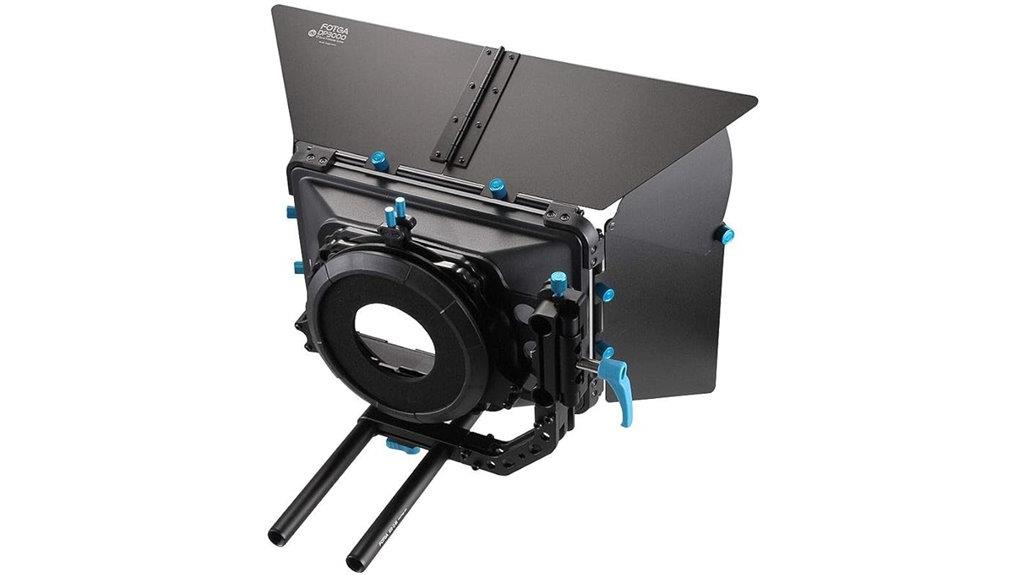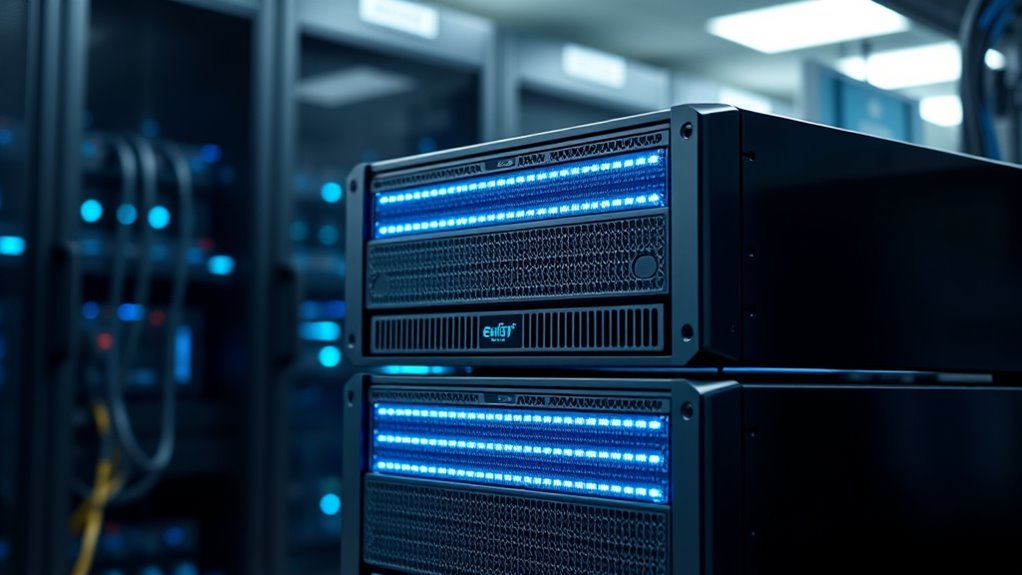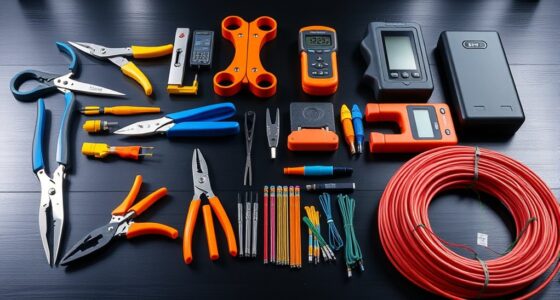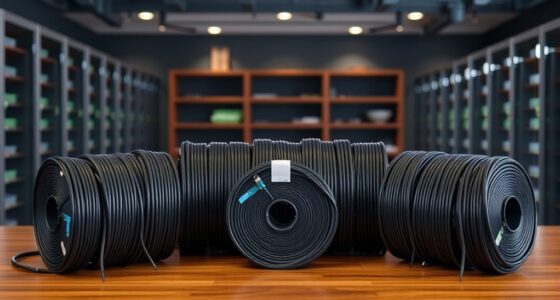If you’re looking to boost your virtualization performance, I recommend considering the Dell EMC PowerMax and Pure Storage FlashArray. Both offer blazing fast speeds, low latency, and seamless scalability, which helps improve VM responsiveness and throughput. They support robust data protection and integrate easily into various environments. Investing in these solutions can lower operational costs and increase efficiency. Keep exploring further, and you’ll discover even more ways these arrays can optimize your data center.
Key Takeaways
- Look for all-flash arrays with high IOPS (over 100,000) and low latency (under 1ms) to enhance VM responsiveness.
- Prioritize scalable solutions that support dynamic capacity expansion and seamless integration with existing hypervisors.
- Choose arrays with robust data protection features like snapshots, replication, and encryption for VM data security.
- Consider arrays offering high throughput (several GBps) to efficiently handle multiple VMs and I/O-intensive workloads.
- Opt for models from reputable vendors known for compatibility, management tools, and proven performance in virtualized environments.
Fotga DP3000 M3 4×4 Swing-Away Matte Box for Camera Rigs

The Fotga DP3000 M3 4×4 Swing-Away Matte Box is ideal for filmmakers and camera operators who need quick, reliable access to their lenses and filters without interrupting their shoot. It fits almost all cameras, from DSLRs to industry-standard 15mm rail systems, ensuring broad compatibility. The swing-away mechanism allows me to change lenses easily without removing my camera from the rig. With two filter trays for 4×4 filters and adjustable flags, I can control light and reduce flare efficiently. Its durable plastic build and versatile design make it perfect for fast-paced shoots, streamlining my workflow and keeping my focus on capturing quality footage.
Best For: filmmakers and camera operators seeking a versatile, quick-access matte box compatible with a wide range of cameras and rig setups.
Pros:
- Broad compatibility with various cameras and 15mm rail systems, including DSLRs and industry-standard rigs
- Swing-away design allows fast lens changes without dismounting the camera
- Equipped with two filter trays and adjustable flags for effective light control and flare reduction
Cons:
- Made of durable plastic, which may be less robust compared to metal alternatives
- Slightly larger and potentially heavier, which could affect portability for some users
- The hinge and flag mechanisms may require careful handling to ensure long-term durability
TERRAMASTER D6-320 External Hard Drive Enclosure

If you’re seeking a versatile external enclosure that delivers high-speed data transfer and large storage capacity, the TERRAMASTER D6-320 is an excellent choice. It uses USB 3.2 Gen2, providing speeds up to 10Gbps, and can handle six drives—either HDDs or SSDs—with a total capacity of up to 132TB. Its hot-swappable design allows for easy drive replacements without power down, while the intelligent fan ensures ideal heat dissipation and quiet operation. Compatible with Mac, Windows, and Linux, it offers plug-and-play simplicity with multiple interfaces, including Thunderbolt. This enclosure is perfect for expanding storage and boosting performance in demanding virtualization environments.
Best For: users seeking high-capacity, high-speed external storage solutions with easy drive management and broad compatibility for professional and personal use.
Pros:
- Supports up to six drives with a total capacity of 132TB, ideal for large data storage needs
- Utilizes USB 3.2 Gen2 with transfer speeds up to 10Gbps for fast data access and transfer
- Hot-swappable design allows for easy drive replacement or addition without powering down
Cons:
- May require additional hardware (like Thunderbolt adapters) for full compatibility with Thunderbolt interfaces
- No included drives; users must purchase compatible SATA HDDs or SSDs separately
- Enclosure is diskless, which might require some technical familiarity for setup and configuration
Factors to Consider When Choosing an All-Flash Array for VM Storage

When selecting an all-flash array for VM storage, I focus on key factors like performance, capacity, and cost to guarantee I meet my specific needs. Compatibility and data protection features are also essential for seamless operation and security. Considering these points helps me choose an array that balances speed, scalability, and budget effectively.
Performance and Speed
Ever wondered how to guarantee your VM storage delivers the speed and responsiveness your workloads demand? All-flash arrays excel here, typically offering latency under 1 millisecond, which drastically improves VM performance over traditional disks. They provide high IOPS, often surpassing 100,000 per array, essential for demanding virtual environments. Data transfer speeds can reach several GBps, enabling faster VM boots and quicker application responses. However, achieving consistent performance depends on factors like SSD quality, controller architecture, and data management algorithms. Features such as multi-path I/O, advanced caching, and intelligent data tiering help maintain steady performance under heavy workloads. When choosing an all-flash array, prioritize these performance features to guarantee your virtualization environment remains fast, responsive, and reliable.
Capacity and Scalability
Choosing an all-flash array that keeps pace with your virtual environment requires careful attention to capacity and scalability. You need to guarantee it offers enough raw storage to meet current needs while leaving room for growth. Evaluate the array’s scalability options, like adding expansion shelves or nodes, to handle increasing data seamlessly. It’s important that the array supports dynamic capacity expansion without significant downtime or complex migrations, so your operations remain uninterrupted. Check the maximum supported capacity per node or enclosure to guarantee it aligns with your long-term plans. Finally, consider whether the architecture allows for incremental scaling, enabling you to expand storage gradually and cost-effectively as your data grows. This flexibility is essential for future-proofing your VM storage solution.
Compatibility and Integration
Ensuring seamless integration between your all-flash array and existing virtualization infrastructure is essential for maintaining peak performance and simplifying management. I look for arrays that support my current hypervisor environment, ensuring compatibility without complicated tweaks. It’s also *vital* that the array meshes well with my network setup, whether Ethernet or Fibre Channel, to maximize data transfer speeds. Supporting standard storage protocols like NVMe, iSCSI, or FC guarantees I can meet my performance and connectivity needs. Additionally, I prefer arrays with robust APIs and management tools that fit into my existing IT workflows, making administration easier. Scalability is another key factor—choosing an array that can grow with my needs without major reconfiguration saves time and effort in the long run.
Data Protection Features
When selecting an all-flash array for VM storage, it’s vital to prioritize robust data protection features that safeguard your virtual machines. Look for solutions that include snapshots, replication, and backup capabilities to prevent data loss and guarantee quick recovery. Built-in encryption, such as AES-256, secures sensitive VM data both at rest and during transit. Automated disaster recovery and failover mechanisms are indispensable for maintaining high availability and minimizing downtime. Data integrity features like end-to-end checksum verification help detect and correct data corruption proactively, preserving data accuracy. Additionally, compatibility with cloud backup and archival solutions offers a thorough layer of protection, making sure your VM data is safe, accessible, and resilient against various threats or failures.
Cost and Budget
While data protection features are essential for safeguarding VM storage, it’s equally important to take into account cost and budget constraints when selecting an all-flash array. All-flash arrays typically have higher upfront costs than traditional spinning disks, requiring a significant capital investment. However, the total cost of ownership also includes maintenance, energy consumption, and potential upgrades over time. Budget limitations might restrict your choice of capacity or performance tiers, affecting drive types and configurations. To maximize value, I recommend balancing performance needs with cost per gigabyte, especially in large-scale deployments. Remember, investing in the right all-flash array can lead to long-term savings through improved VM performance, less downtime, and lower operational expenses over the system’s lifecycle.
Frequently Asked Questions
How Does All-Flash Storage Impact VM Backup and Recovery Times?
All-flash storage substantially speeds up VM backup and recovery times. I’ve seen data transfer rates jump, making backups quicker and restores almost instant. This reduces downtime and minimizes disruption to my operations. Plus, the low latency of flash means I can access my backed-up data faster when I need to recover a VM. Overall, it’s a game-changer for ensuring my virtualization environment is resilient and efficient.
What Are the Best Practices for Integrating All-Flash Arrays Into Existing Infrastructure?
To integrate all-flash arrays smoothly, I recommend evaluating your current infrastructure first. Make sure your network can handle the increased data speeds, and plan for proper capacity management. I always suggest starting with a pilot project to test compatibility and performance. Keep backups handy, and coordinate with your team for seamless implementation. Regularly monitor and optimize settings to ensure you’re getting the most out of your all-flash storage.
How Does Data Redundancy Work in All-Flash Arrays for VM Environments?
Did you know that 90% of data loss in VM environments can be prevented with proper redundancy? In all-flash arrays, data redundancy works through techniques like RAID, mirroring, and erasure coding. These methods guarantee that if one drive fails, your data remains safe and accessible. I’ve seen these systems keep critical workloads running smoothly, even during hardware failures, giving me peace of mind knowing my VMs are protected.
What Are the Cost Implications of Deploying All-Flash Storage at Scale?
Deploying all-flash storage at scale can be expensive upfront due to higher hardware costs. However, I find that the benefits—faster data access, improved VM performance, and reduced latency—often lead to lower operational costs over time. You’ll need to evaluate factors like licensing, maintenance, and scalability. Overall, it’s an investment that pays off through enhanced efficiency, especially in demanding virtualized environments.
How Do All-Flash Arrays Handle Mixed Workloads and Varying VM Sizes?
All-flash arrays handle mixed workloads and varying VM sizes efficiently by leveraging advanced data management features like tiering, caching, and Quality of Service (QoS). These features prioritize performance for critical VMs while optimizing storage for less demanding ones. I’ve found that this flexibility guarantees consistent speed across diverse workloads, preventing bottlenecks and maximizing resource utilization, which ultimately boosts overall virtualization performance.
Conclusion
Just like a finely tuned sports car accelerates with precision, choosing the right all-flash array can turbocharge your VM storage and boost your virtualization performance. By considering performance, capacity, compatibility, and data protection, you’ll guarantee smooth and reliable operation—think of it as giving your infrastructure the sleek, powerful engine it deserves. Don’t settle for slow drives; upgrade now and let your virtual environment run like a well-oiled machine.








